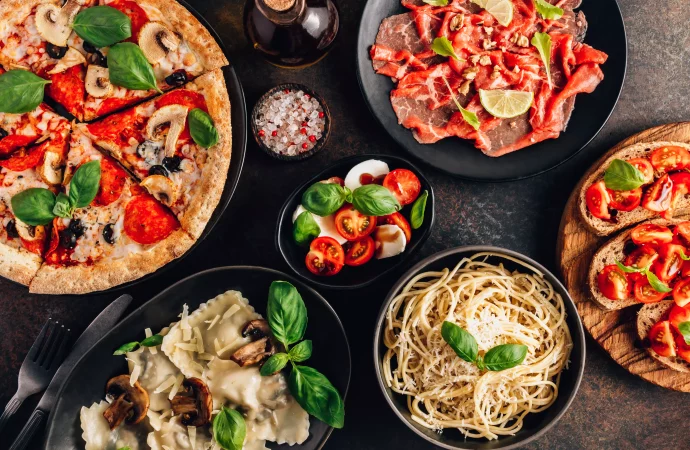Introduction Italian cuisine is more than just food; it’s a passionate affair, a celebration of life, and a testament to the art of simplicity. Known worldwide for its emphasis on fresh, high-quality ingredients and time-honored cooking traditions, Italian cuisine has captured the hearts and taste buds of people around the globe. In this culinary journey,
Introduction
Italian cuisine is more than just food; it’s a passionate affair, a celebration of life, and a testament to the art of simplicity. Known worldwide for its emphasis on fresh, high-quality ingredients and time-honored cooking traditions, Italian cuisine has captured the hearts and taste buds of people around the globe. In this culinary journey, we’ll explore the soul-warming dishes that define Italian gastronomy, from the comforting embrace of pasta to the rustic charm of pizza and the creamy elegance of risotto.
The Heart of Italian Cooking: Quality Ingredients
Great Italian cuisine begins with quality ingredients. Italians believe that using fresh, seasonal produce and artisanal products creates the best dishes. Key staples include:
- Olive Oil: Extra-virgin olive oil adds rich, fruity notes to salads, pasta sauces, and marinades.
- Tomatoes: Ripe plum tomatoes or San Marzano varieties offer sweet acidity in sauces.
- Cheese: Parmesan, mozzarella, and ricotta bring creamy texture and depth.
- Fresh Herbs: Basil, oregano, and parsley add bright, herbal aromas.
- Garlic and Onions: These aromatics form the flavorful base of countless Italian recipes.
By choosing the best olive oil and vine-ripened tomatoes, you set the stage for truly authentic Italian cooking.
Mastering Pasta Dishes
Pasta is the backbone of Italian cuisine, and there are hundreds of shapes to explore. Here are some classic pasta dishes and tips to master them:
1. Spaghetti al Pomodoro
A simple sauce of tomatoes, garlic, and basil brings out the pure taste of the ingredients. Cook spaghetti until al dente, then toss with the sauce and a drizzle of olive oil. Top with grated Parmesan for extra richness.
2. Fettuccine Alfredo
This creamy dish uses butter, heavy cream, and Parmesan. To prevent a greasy sauce, melt butter first, add warm cream, then whisk in cheese off the heat. Toss in fresh fettuccine and serve immediately.
3. Penne all’Arrabbiata
For a spicy kick, simmer garlic, chili flakes, and tomatoes. Toss with penne, then garnish with parsley. The heat balances the sweet-tart tomato flavor perfectly.
4. Lasagna alla Bolognese
Layers of pasta sheets, rich meat ragu, béchamel sauce, and cheese make this dish a hearty centerpiece. Slow-cook the ragu for depth, and allow the lasagna to rest before cutting for neat slices.
When cooking any pasta dish, reserve a cup of pasta water to adjust sauce consistency. The starch helps bind sauce to the noodles and creates a silky finish.
The Essence of Italian Cuisine

Image by: Yandex.com
At the core of Italian cuisine is a deep respect for ingredients. Italians believe that the quality of each component is paramount. From the ripest tomatoes to the finest olive oil, Italian dishes shine because of their dedication to sourcing the best. In Italy, the food reflects the diversity of its regions, each offering its own unique flavors and specialties.
1. Pasta: The Heart of Italian Cuisine
Pasta is the undisputed star of Italian cuisine. From the delicate strands of angel hair pasta to the hearty spirals of fusilli, pasta comes in countless shapes and sizes, each with its intended purpose. It serves as the canvas for a myriad of sauces, from the classic marinara to the luxurious Alfredo. Whether it’s the simplicity of spaghetti aglio e olio or the indulgence of lasagna, pasta unites Italy and the world in a love affair with food.
2. Pizza: The Quintessential Comfort Food
No culinary journey through Italy is complete without a slice of pizza. Originating in Naples, pizza has evolved into an international sensation. The classic Margherita, adorned with tomatoes, mozzarella, basil, and a drizzle of olive oil, showcases the essence of Italian flavors. However, pizza varies greatly across Italy’s regions, offering an array of toppings and styles to discover.
3. Risotto: Creamy Elegance in a Bowl
Risotto, a creamy rice dish, embodies Italian elegance. The slow, patient cooking process allows the rice to absorb rich broth, creating a luxurious texture. Whether it’s saffron-infused risotto alla milanese or the earthy goodness of mushroom risotto, this dish exemplifies the Italian commitment to perfection in every bite.
4. The Magic of Italian Sauces
Italian cuisine is renowned for its diverse range of sauces. From the fresh and zesty marinara to the hearty and meaty ragù, these sauces are the soul of Italian dishes. They transform humble ingredients into extraordinary meals. The secret lies in the balance of flavors, a handful of fresh herbs, and the love with which they are prepared.
Dining Traditions and Etiquette
Sharing a meal is central to Italian culture. Family tables brim with multiple courses:
- Antipasto begins with cured meats, cheeses, olives, and bruschetta.
- Primo features pasta, risotto, or soup.
- Secondo brings protein—meat, fish, or vegetables.
- Contorno offers side dishes like salad or roasted vegetables.
- Dolce ends with sweet treats such as gelato, tiramisu, or panna cotta.
Meals often last two hours or more, encouraging conversation and connection. Toasting with a glass of wine—Prosecco in the north or Nero d’Avola in Sicily—is a gesture of friendship and celebration.
Cooking Tips for Home Chefs
You don’t need a pizza oven to enjoy Italian dishes at home. Follow these tips:
- Salt pasta water well: It should taste like the sea to season your pasta from within.
- Reserve pasta water: A splash helps sauces cling and creates a silky texture.
- Cook sauces low and slow: Develop depth of flavor by simmering tomatoes gently.
- Use a pizza stone or steel: Preheat it for at least 30 minutes to mimic a wood-fired oven’s heat.
- Dress salads simply: A drizzle of olive oil, a squeeze of lemon, and a pinch of salt is all you need.
- Embrace leftovers: Transform extra pasta into baked dishes or frittatas for next-day meals.
With a little practice, you can bring authentic taste and warmth to your kitchen.
The Art of Italian Hospitality
In Italy, hospitality is an art form. Hosts welcome guests with open arms and generous spreads. Food is never rushed; it is savored slowly. Whether sharing antipasti on a sunny terrace or gathering around a wood-fired oven, Italians create lasting memories through food. Embrace this spirit at home by cooking with care, serving with a smile, and inviting friends and family to dine together.
Conclusion
Italian cuisine is a reflection of Italy’s soul, a celebration of life’s simple pleasures. It’s a reminder that the best meals are often the ones made with love and the finest ingredients. Whether you’re savoring a bowl of handmade pasta in a rustic trattoria or relishing a slice of pizza on the bustling streets of Naples, Italian cuisine invites you to embrace the joy of good food, good company, and the rich tapestry of flavors that define this culinary treasure.
So, as you embark on your culinary journey, let Italian cuisine be your guide, and allow its rich history and timeless flavors to transport you to the heart of Italy, where every meal is a celebration of life itself.























Leave a Comment
Your email address will not be published. Required fields are marked with *